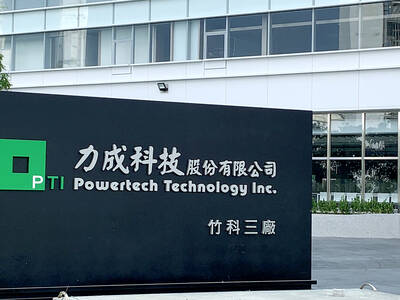Taiwan’s foreign exchange reserves fell by US$563 million last month to US$597.87 billion, as a broadly stronger US dollar reduced the value of non-dollar assets, the central bank said yesterday.
The decline, while modest, reflects renewed investor focus on US macroeconomic fundamentals and a normalization in global capital flows, Department of Foreign Exchange Director-General Eugene Tsai (蔡炯民) told reporters.
The greenback gained more than 3 percent during the month, weighing on holdings denominated in euros, pounds, yen and other currencies. The New Taiwan dollar depreciated 2.47 percent against the greenback during the same period.

Photo: George Tsorng, Taipei
The drop in reserves was not due to capital outflows or heavy foreign exchange market intervention, but rather valuation effects amid a return to fundamentals-based pricing in the currency markets, he said.
Citing earlier pressure on the US dollar this year due to fears of a potential debt default tied to US Treasury maturities in June, as well as speculation surrounding a so-called “Mar-a-Lago Accord,” Tsai said the theory — suggesting coordinated efforts to weaken the US dollar — is unfounded.
With those concerns easing, the market has returned to pricing currencies based on economic data, interest rate differentials and the US dollar’s role as a global reserve currency, he said.
Despite the decline in foreign exchange reserves, capital inflows remained robust, he added.
Foreign investors were net buyers of Taiwanese equities last month, recording more than NT$200 billion (US$6.68 billion) in net inflows, as the benchmark TAIEX rose 5.78 percent during the month.
“Speculative capital has retreated, and the US dollar has regained strength and stability,” Tsai said, adding that foreign capital flows have become more aligned and orderly compared with the volatility seen in prior months.
The central bank previously attributed sharp gains in the NT dollar to speculative capital inflows and panic selling of US dollars by local exporters and financial institutions with significant foreign currency exposures.
The central bank continues to communicate with foreign banks and institutional investors to ensure that funds are used in accordance with their declared purposes, he said.
The central bank briefly intervened in the foreign exchange market in early last month to reduce volatility, but largely remained on the sidelines as market conditions later stabilized, he added.
The US dollar is unlikely to depreciate significantly over the remainder of the year, with markets having already priced in 50 basis points of interest rate cuts from the US Federal Reserve and “reciprocal” tariff measures largely resolved, Tsai said.
“The US dollar remains fundamentally supported by higher interest rates, compared with other major currencies,” Tsai said, suggesting that the NT dollar might hold steady at about NT$29.9 with mild depreciation pressure, if current trends persist.

The DBS Foundation yesterday announced the launch of two flagship programs, “Silver Motion” and “Happier Caregiver, Healthier Seniors,” in partnership with CCILU Ltd, Hondao Senior Citizens’ Welfare Foundation and the Garden of Hope Foundation to help Taiwan face the challenges of a rapidly aging population. The foundation said it would invest S$4.91 million (US$3.8 million) over three years to foster inclusion and resilience in an aging society. “Aging may bring challenges, but it also brings opportunities. With many Asian markets rapidly becoming super-aged, the DBS Foundation is working with a regional ecosystem of like-minded partners across the private, public and people sectors

BREAKTHROUGH TECH: Powertech expects its fan-out PLP system to become mainstream, saying it can offer three-times greater production throughput Chip packaging service provider Powertech Technology Inc (力成科技) plans to more than double its capital expenditures next year to more than NT$40 billion (US$1.31 billion) as demand for its new panel-level packaging (PLP) technology, primarily used in chips for artificial intelligence (AI) applications, has greatly exceeded what it can supply. A significant portion of the budget, about US$1 billion, would be earmarked for fan-out PLP technology, Powertech told investors yesterday. Its heavy investment in fan-out PLP technology over the past 10 years is expected to bear fruit in 2027 after the technology enters volume production, it said, adding that the tech would

YEAR-END BOOST: The holiday shopping season in the US and Europe, combined with rising demand for AI applications, is expected to drive exports to a new high, the NDC said Taiwan’s business climate monitor improved last month, transitioning from steady growth for the first time in five months, as robust global demand for artificial intelligence (AI) products and new iPhone shipments boosted exports and corporate sales, the National Development Council (NDC) said yesterday. The council uses a five-color system to measure the nation’s economic state, with “green” indicating steady growth, “red” suggesting a boom and “blue” reflecting a recession. “Yellow-red” and “yellow-blue” suggest a transition to a stronger or weaker condition. The total score of the monitor’s composite index rose to 35 points from a revised 31 in August, ending a four-month

RUN IT BACK: A succesful first project working with hyperscalers to design chips encouraged MediaTek to start a second project, aiming to hit stride in 2028 MediaTek Inc (聯發科), the world’s biggest smartphone chip supplier, yesterday said it is engaging a second hyperscaler to help design artificial intelligence (AI) accelerators used in data centers following a similar project expected to generate revenue streams soon. The first AI accelerator project is to bring in US$1 billion revenue next year and several billion US dollars more in 2027, MediaTek chief executive officer Rick Tsai (蔡力行) told a virtual investor conference yesterday. The second AI accelerator project is expected to contribute to revenue beginning in 2028, Tsai said. MediaTek yesterday raised its revenue forecast for the global AI accelerator used